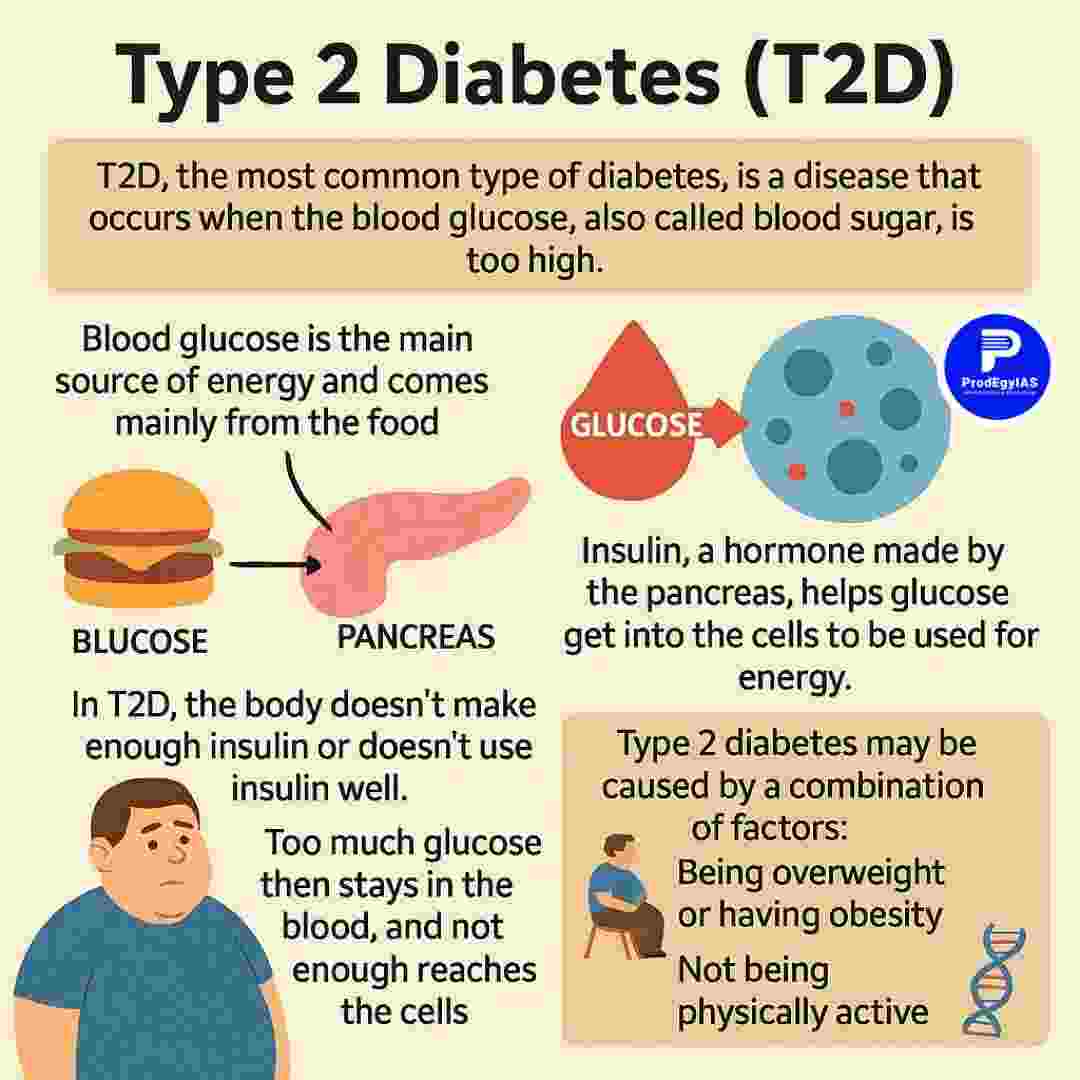Relevance: GS II: Government Policies and Health
Table of Contents
ToggleWhat is Type 2 Diabetes (T2D)? Causes, Symptoms, and CBSE’s New Initiative
In CBSE classrooms, sugar boards will inform children about the dangers of consuming too much sugar and talk about better food options. Students will use these boards to combat obesity and Type 2 diabetes.
Understanding Type 2 Diabetes (T2D)
When blood sugar levels rise due to improper insulin usage, type 2 diabetes develops. Previously, it was known as adult-onset diabetes.

What Happens in the Body During T2D?
Type 2 diabetes’s elevated blood sugar levels over time can harm the heart, kidneys, nerves, and eyes. This may occur as a result of insufficient production of the hormone insulin by the pancreas, which facilitates the uptake of sugar by cells. It also occurs because the cells absorb less sugar in response to insulin.
The Role of Insulin and Blood Sugar Regulation
A gland located beneath and behind the stomach produces the hormone insulin. The pancreas is the name of the gland. The following are some ways that insulin controls the body’s usage of sugar: When the blood sugar level falls, the pancreas produces less insulin. Blood sugar induces the pancreas to create insulin, which then transports sugar into the cells.
- The primary energy source for the cells that comprise muscles and other tissues is a molecule known as glucose. There are two main sources of glucose. They are the liver and food. It enters the bloodstream as glucose. With insulin’s assistance, it enters cells there.
Key Causes of Type 2 Diabetes
The primary causes of type 2 diabetes are two problems: The liver, muscle, and fat cells do not react to insulin as they should. The cells don’t absorb enough sugar as a result.
- The pancreas, which produces insulin, is unable to produce enough of it to maintain blood sugar levels within a safe range.
Note: Stay informed about the most recent UPSC current Affairs, where we provide clear explanations of the major stories.
Symptoms of T2D
Type 2 diabetes symptoms frequently appear gradually. In actuality, persons with type 2 diabetes may go years without realizing it. When symptoms are present, they could consist of:
- More thirst.
- More urination.
- More appetite.
- reduction of weight.
- fatigue.
- visual impairment.
- sores that heal slowly.
- recurring infections.
- tingling or numbness in the hands or feet.
- patches of darker skin, usually found in the neck and armpits.
Prevention
Consume nutritious foods. Select foods that are higher in fiber and lower in calories and fat. Give priority to whole grains, fruits, and veggies.
- Take action. Aim for 150 minutes or more of moderate-to-intense aerobic exercise per week, such as swimming, brisk walking, cycling, or running.
- Reduce your weight. If you are overweight, you may be able to prevent type 2 diabetes by reducing a little weight and maintaining it. Diabetes risk may be reduced if you lose 7% to 10% of your body weight if you have prediabetes.
- Avoid prolonged sitting. Long periods of sitting can increase the risk of type 2 diabetes. Every half an hour, get up and spend a few minutes moving around.
CBSE’s Initiative to Prevent Type 2 Diabetes in Children
In order to track and lower student sugar intake, the Central Board of Secondary Education (CBSE) has written to the principals of each of its associated schools requesting that they establish “Sugar Boards.” The main goal of this effort is to reduce children’s risk of Type 2 diabetes and obesity.
- According to CBSE, children who consume “sugary snacks, beverages, and processed foods” are at risk for developing diabetes.
Introduction of “Sugar Boards” in Schools
Students will learn about the dangers of consuming too much sugar from the “Sugar Boards.”
- Additionally, it will explain the sugar content of cold beverages, junk food, and other foods, as well as the health hazards linked to consuming large amounts of sugar. It will also tell them about the appropriate daily intake of sugar. Healthy food options will also be discussed by the Sugar Boards in all CBSE schools.
- The goal of this program is to assist students in making healthier dietary choices and fostering long-term health-promoting behaviors. In order to increase awareness of the dangers of consuming too much sugar, CBSE has also directed schools to host lectures and workshops.
Note: To take practice tests on Daily current Affairs MCQs, click the link that is attached.
| MCQ Question: Consider the following statements regarding Type 2 Diabetes (T2D):
Which of the statements given above is/are correct? a) 1 and 2 only b) 3 only c) 2 and 3 only d) 1, 2 and 3 Answer: b) 3 only |
Source: CBSE schools to set up ‘Sugar Boards’ to fight Type 2 diabetes, obesity among students
UPSC General Studies Paper Preparation
| Topic | |
| UPSC Syllabus | GS Genius-50 Program |
| Public administration crash course | UPSC GS Mains 2025 Study Material |
| About the Author: Nitin Kumar Singh |



